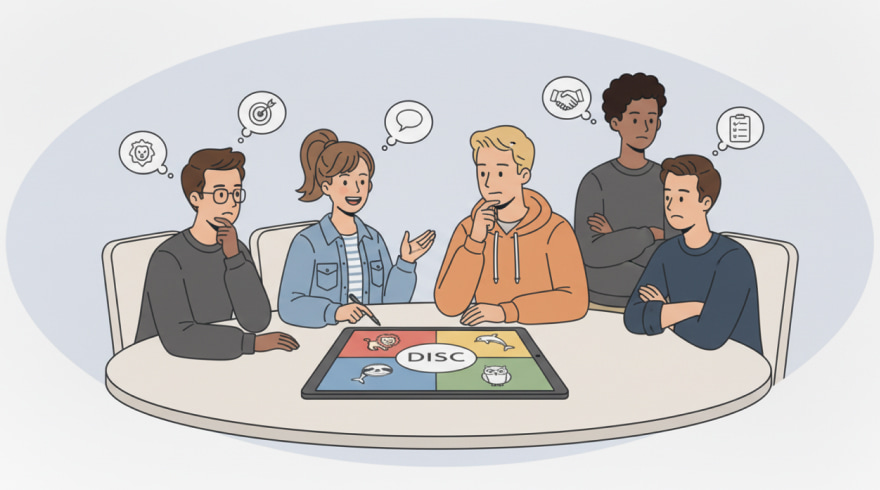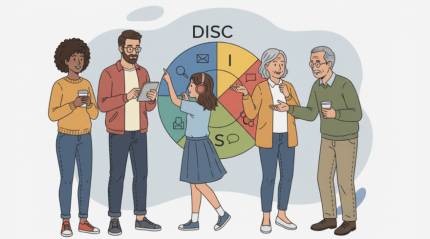Discover Your Behavioral Style: Understanding DISC for Personal Growth
- 30 October 2025

Take DISC Personality Assessment Online
Get StartedWhat Is DISC and Why Does It Matter
People communicate, decide, and respond under pressure in predictably different ways, and the DISC framework offers a practical lens for making sense of those patterns. Rather than boxing anyone in, the model highlights observable behaviors and typical preferences, which helps individuals and teams anticipate needs, reduce friction, and align expectations. With plain language and actionable insights, DISC equips readers to act on what they learn, not just admire a colorful chart from afar.
Clarity starts with definitions, and experienced facilitators emphasize that labels are only a doorway to deeper self-awareness, not a destination. Experts still debate terminology, yet the phrase the DISC test personality continues to circulate among newcomers to the framework today. Beyond the buzzwords, the best programs teach you to translate tendencies into choices, so that your natural strengths are amplified and your blind spots are managed with intention.
Understanding purpose matters even more than memorizing letters, because sustainable change comes from connecting insights to routines. Beyond labels, the meaning of DISC personality test rests in how you translate patterns into daily habits that produce results. Practical benefits appear in small moments, writing clearer messages, delegating based on strengths, and pacing meetings so every contributor can engage.
- Build a shared language so feedback feels specific and supportive.
- Anticipate stress responses and plan recovery strategies before crunch time.
- Design workflows that respect speed, detail, and interaction preferences.
- Improve hiring conversations by aligning role demands with behavioral strengths.
When used ethically, DISC becomes a catalyst for empathy and effectiveness, giving individuals a way to flex behaviors without losing authenticity or momentum.
How to Take a Quality Assessment and Use the Results
Not all questionnaires are created equal, and your experience will improve dramatically when you choose instruments with transparent scoring and practical guidance. For a quick snapshot, a free DISC personality test can act as a low-friction starting point for self-reflection. If you want to compare options, look for evidence of validation, clear instructions, and plain-English feedback that turns scores into strategies you can apply this week.
It helps to think in phases: prepare, take, interpret, and apply. You can explore deeper without paying, and the DISC personality test free option helps you sample core insights today. When selecting vendors, ensure the DISC personality assessment test you use includes validity notes and clear scoring rubrics for readers. After completing your questionnaire, block time to read calmly, highlight practical ideas, and select a few behavior experiments to try in upcoming conversations.
Choosing the Right Format
Some people prefer a quick browser-based quiz, while others lean toward structured tools with richer reports. The matrix below contrasts typical paths so you can pick what fits your goals and constraints without guesswork.
| Option | What You Get | Best For |
| Basic Online Quiz | Fast overview, brief tips, limited depth | First-time explorers and light comparisons |
| Validated Assessment | Reliability notes, detailed style blends, scenarios | Serious learners and team initiatives |
| Facilitated Debrief | Expert interpretation, action planning, Q&A | Leaders, intact teams, and change projects |
- Schedule 15–20 uninterrupted minutes to complete your questionnaire.
- Answer quickly and honestly, focusing on typical behavior, not aspirations.
- Highlight 3 insights and convert each into one behavioral experiment.
- Share takeaways with a colleague to create accountability and perspective.
Whether you self-serve or partner with a coach, the goal is the same: turn insights into repeatable practices that improve outcomes in real conversations, meetings, and decisions.
Understanding the Styles and the Underlying Model
Under the hood, DISC maps how people approach problems, pace, processes, and people, revealing patterns that influence communication and decision-making. Under the hood, a DISC model personality test compares how you respond to problems, pace, people, and procedures in typical settings. Rather than treating styles as fixed traits, the best explanations illustrate a spectrum of behaviors, including how context and pressure can shift your go-to responses.
Many learners first meet the framework through a colorful 4 personality styles test that maps preferences onto four memorable quadrants for clarity. While that simplicity is useful, nuanced tools describe blends and intensity, which explains why two individuals with similar letters can still look different in meetings or email threads. Paying attention to energy drivers and stressors will help you choose strategies that feel natural and sustainable over time.
Deeper dive reports extend a DISC personality types test with nuances like situational stretch goals and conflict triggers across contexts. To interpret any profile wisely, look for statements that feel both specific and fair, then test them against recent experiences. When patterns ring true, you can design experiments, like adjusting pace, adding detail, or asking clarifying questions, that close gaps and unlock smoother collaboration without sacrificing authenticity.
- Observe behavior in real settings to validate report claims.
- Compare natural tendencies with adapted behaviors under pressure.
- Translate insights into meeting norms and communication checklists.
- Review progress monthly and refine tactics based on outcomes.
From Insight to Action: Everyday Uses at Work and Home
Great assessments translate into better conversations, clearer decisions, and easier collaboration. For team offsites, a facilitated DISC personality profile test can anchor exercises that build empathy and shared norms effectively. Managers can use insights to tailor feedback, delegate wisely, and pace change initiatives in ways that reduce friction and boost adoption. Families and partners also benefit by learning to ask for what they need with language that feels respectful and concrete.
If you prefer offline worksheets, some libraries host a DISC personality test free download that pairs with facilitator guides and tip sheets. Printed prompts can be handy during workshops where devices are discouraged, and they help participants focus on DISCussion rather than screens. Regardless of format, ensure privacy is respected and that participants choose what to DISClose, so psychological safety remains intact.
- Use shared language to streamline handoffs and reduce rework.
- Design agendas that balance speed, detail, and discussion time.
- Create conflict agreements that outline how to pause and reset.
- Pair complementary strengths on projects requiring both pace and precision.
When leaders model curiosity and flexibility, teams internalize the message that styles are resources to be coordinated, not labels to be weaponized. Over time, those habits compound into trust, efficiency, and results you can measure.
Choosing Tools, Ethics, and Accuracy
Quality matters, and ethical use matters even more. In organizational rollouts, an accredited DISC assessment personality test reduces bias and aligns language across teams for smoother collaboration. Look for instruments with clear development histories, balanced narratives, and guidance that avoids stereotyping while encouraging choice and accountability. Remember that assessments are one data point among many; pair them with observation, feedback, and performance outcomes.
Budget-conscious groups often pilot with a DISC personality types test free before commissioning enterprise analytics and dashboards later. As programs scale, invest in facilitator training, build internal champions, and create playbooks so insights do not sit in a drawer. Protect privacy by collecting only necessary data, storing it securely, and setting retention timelines that respect local regulations and employee expectations.
- Choose validated instruments and publish selection criteria for transparency.
- Offer opt-in participation and clarify how insights will be used.
- Provide debriefs to help participants convert results into practical steps.
- Evaluate impact using metrics like cycle time, engagement, and retention.
When you combine credible tools with thoughtful implementation, the result is a shared language that elevates performance while honoring individual dignity and diversity.
FAQ: Common Questions About DISC
Is DISC a personality or behavior framework?
DISC focuses on observable behavior and communication tendencies rather than diagnosing personality in a clinical sense. It describes how you typically approach tasks and relationships, then suggests flexible strategies to match context. This emphasis on behaviors makes the insights easy to apply without medical labels or complex jargon.
How accurate are online quizzes compared to validated tools?
Quick quizzes can provide a helpful introduction, but validated instruments include reliability studies, norming samples, and balanced narratives that reduce bias. Accuracy improves when you answer honestly, reflect on typical behavior, and review results with someone trained to interpret patterns and translate them into practical experiments.
Can DISC be used for hiring decisions?
Use caution. DISC can inform conversations about role demands, communication, and onboarding, but it should not be the sole basis for hiring decisions. Combine multiple data points, skills, experience, work samples, and references, and ensure fair, consistent processes that comply with local laws and ethical guidelines.
How often should I retake an assessment?
Retake when your role, environment, or goals change significantly, or every 12–24 months to check for shifts. Behavior adapts with context, so fresh data can reveal new stretch areas. Keep prior reports to compare patterns and refine action plans rather than chasing letter changes for their own sake.
What is the best way to apply my results?
Pick two or three micro-behaviors you can test immediately, such as adjusting meeting pace, adding context to requests, or asking clarifying questions. Share your plan with a colleague, gather feedback, and track outcomes. Small, repeatable changes compound into better collaboration and more predictable results over time.



